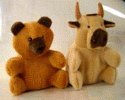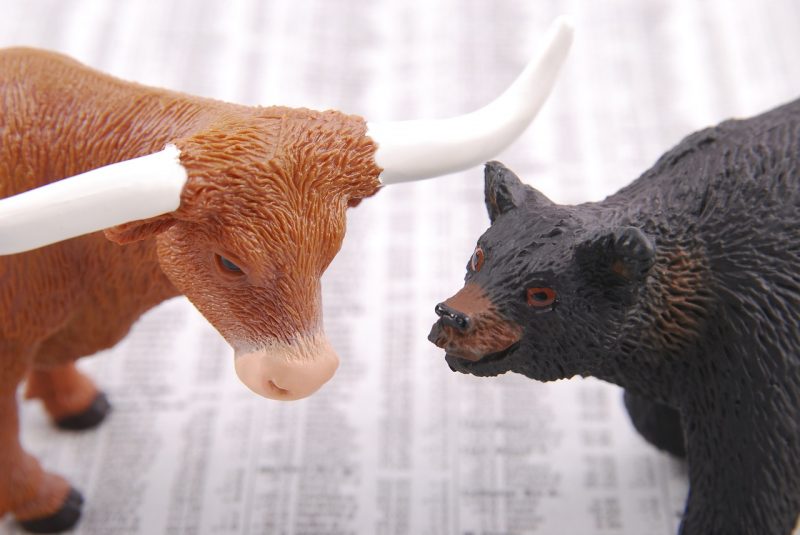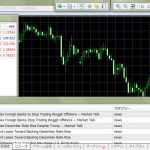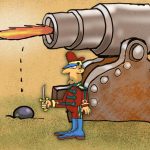FXトレードに限らず、相場に関わったことのある人なら一度は目にしたことがある「ブル・ベア」という言葉。
「FX専門用語解説」シリーズとして、FXにまつわる用語・単語を取り上げていますが、この記事では、「ブル・ベア」の意味やその由来、いろいろな関連情報をお伝えしていきます。
ブル・ベアの意味はシンプル。色々な相場状況で使われる
「ブル」とは、「強気、買い、上昇」を意味し、「ベア」とは、「弱気、売り、下落」を意味する相場用語です。
この「ブル・ベア」という言葉ひとつに、いろいろなニュアンスが含まれているので、様々な相場状況で使われています。
例えば上昇トレンドが明らかな相場状況のことを、「ブル・マーケット(ブル相場)」と呼びます。下降トレンドなら「ベア・マーケット(ベア相場)」です。
ブル・ベアという言葉がつかわれるのは、主に株式相場というイメージですが、実際には為替取引(FX)、先物取引など、あらゆる金融市場で用いられています。
また、株式相場で「これから相場が上昇するぞ!」という強気の見方を、「これからブルだ!」というふうに表現したりします。
相場参加者たちの気分・ムード・雰囲気をあらわすケースとして、「今の相場はベアにおびえている」という具合にも使われます。
ブル・ベアという名前の通り、その言葉からは「雄々しい雄牛」と「猛々しい熊」がイメージされるので、厳しい相場の現実を示すものとして相応しく、相場の状況や相場への思いを託しやすいのだと考えられます。
少し特殊な用例としては、移動平均線(MA)よりもレートが上に位置している状態を「ブル」、反対にレートがMAの下に位置している状態を「ベア」と呼ぶことがあります。
この場合、移動平均線のパラメータ(何期間の平均レートを用いるか)によって、ブルかベアかの判断は変わってくるので、余程コンセンサス(共通認識)が得られている移動平均線でなければ意味がないともいえます(例えば200日移動平均線など)。
しかし、常に一定の移動平均線をトレードに用い続けることによって、いうなれば相場参加者の集団心理を読む「ものさし」のような役割を果たしてくれるようになるので、この「ブル・ベア」の呼び方を好むトレーダーも一定数存在します。
ブル・ベアの名前の由来には諸説あり
それにしても、なぜ上昇相場や下落相場のことを「ブル」と「ベア」──「雄牛」と「熊」と呼ぶようになったのでしょうか?
その由来を追ってみましょう。
一番ポピュラーな由来
雄牛は相手を攻撃するとき、そのツノを「下から上へ」突き上げます。
その姿が「相場が上昇する様子」を彷彿とさせることから、「上昇、強気」のことを「ブル」と呼ぶようになったと言われています。
そして熊は、同じく相手を攻撃するとき、するどいツメのある手を「上から下へ」振り下ろします。
その姿が「相場が下落する様子」をイメージさせるので、「下落、弱気」のことを「ベア」と呼ぶようになったと言われています。
これがブル・ベアについての、最もポピュラーな由来です。
雄牛と熊というのが、アメリカ~カナダの大自然をイメージを彷彿とさせ、とても「らしい」感じがします。


- トレーダーズショップ開店一周年に誕生して以来、ずっと売れ続けている人気ブルベアグッズNo.1。リバーシブル仕様なので、熊を裏返すと牛があらわれます。
米国の証券取引所での立会い取引の様子が由来?
その昔、米国の証券取引所での売買は、立会人たち同士のコミュニケーションによって行われていました(日本の証券取引所もIT化されるまで同様でした)。
株の売買が行われる「立会所」はとても広い空間で、人々の熱気と狂騒によって騒がしく、とてもまともに会話ができるような状況ではありませんでした。
そこで売買には、手や腕をつかったサイン(手ぶり)が用いられていました。
当時の様子がよく分かる動画があります。立会所取引が行われていた時代の東京証券取引所での株の売買の様子です。
貴重な資料ですので、ぜひ見てみて下さい。
──ご覧のように、売買では手を使ったサインを使っていました。
そして米国の証券取引所では「買い」のときには手を手前から後ろに動かしてサインを出していました。
この姿が「雄牛がツノを突き上げる様子」によく似ていたことから、ブルが「買い(強気)」を表すようになった、という説です。
同じく「売り」は、熊が手を振りおろす動作と似ていたから「ベア」だというわけです。
ブル・バイティングという意外な説も
そもそも、なぜ「ブル/雄牛」と「ベア/熊」なのか、その由来を知る手がかりとなる、興味深い説があります。
18世紀から19世紀前半のイギリスでは、ブル・バイティングという「闘犬と雄牛を戦わせる見世物」が大人気となって、盛んに行われていたといいます。
同じように、「闘犬と熊を戦わせる」というベア・バイティングもあったそうです。
小さな闘犬が大きな雄牛や熊と戦い、そして勝利するという、そんなドラマティックな場面を生み出すために、小型の闘犬が交配によって生み出されたほどです。
ちなみに、その名も「スタッフォードシャー・ブル・テリア」という、小型の闘犬種も存在しました。
こうした文化的な背景から、血がたぎるような相場の熱気と、熱狂的な闘犬試合というものがイメージとして結びついて、自然と「雄牛と熊」になったのだと考えられています。
ベアの由来は「冬眠」するから?
さらに「ベア」の由来としては、次のようなものがあります。
熊は冬になると冬眠します。
つまり冬の熊は「まったくアクティブではない(動きがない)」わけです。
そこで、人々が株を売り払ってしまって相場が下落したり、人々が株式市場や為替市場から離れてしまった様子を「ベア」という、という説です。
この説は、私が今回調べてみて初耳だったのですが、ネット上ではこれ以上の情報は得られませんでした。
「取らぬ狸の~」ならぬ「取らぬ熊の皮算用」という説
もうひとつの説としては、ある「ことわざ」に由来しているというものがあります。
海外のことわざに「熊を捕まえる前に熊皮を売る」というものがあります。
さらに、戒めの意味を込めて「熊を捕まえる前に熊皮を売るな!」という表現もあります。
これは日本の「取らぬ狸の皮算用」と同じ意味で、「捕まえる前から皮の利益のことを考える欲深さを表す」という意味があります。
さてその昔、米国の株式相場が大暴落になったとき、目先の効いた相場師たちは、大量の空売りを仕掛けて大儲けをしました。
ちなみに、有名な相場師であるジェシー・リバモアもその一人です(彼の愛称は、なんとグレート・ベア!)。
空売りとは簡単にいうと、手元に株がないにもかかわらず「まず売ったことにしておく」ことでポジションをもつという、信用取引の方法です。
利益の元となる株を持っていないのに利益を得ようとするという意味で、「熊を捕まえる前に熊皮を売っている」ことになるわけです。
空売りをした彼らが見せたその見事なまでの手腕は、いうなれば「熊を捕まえる前に熊皮を売って大成功した」というべきものでした。
その強烈な印象から、人々の間で「暴落=熊/ベア」という連想が定着した──という説です。
ブル・ベアを日本風にいうと、「雄牛とタヌキ」ということになりますが、これだと何ともマヌケな印象になりますね(笑)。
強気派と弱気派の割合を示した指標「ブルベア指数」
ここまで色々なブル・ベアの由来をいろいろ見てきましたが、米国の株式市場には、その名もズバリ「ブルベア指数」というものがあります。
ブルベア指数とは、相場に対して「ベア=強気である」という勢力と、「ベア=弱気である」という勢力とが、どのくらいの割合になっているかを示したものです。
例えば、「現在、相場参加者の6割ほどは、今の状況を”強気”と捉えている」ということが分かる指標です。
ブルベア指数の種類
ブルベア指数には二種類あります。
ひとつは、AAII(American Association of Individual Investors)が発表する、インベスター・センチメント。
もうひとつは、インベスターズ・インテリジェンス社が発表する、センチメント・インデックスです。
インベスター・センチメントは、AAIIの会員の個人投資家を対象に、米国株式市場の先行きに対しての「ブルかベア、もしくは中立かの見解」の割合を調査したものです。
センチメント・インデックスは、独立系調査会社が発行する市場レポートを調査して、同じようにブル、ベア、中立の割合を調査して発表されています。
参考リンク AAII 公式サイト
参考リンク インベスターズ・インテリジェンス 公式サイト
その使い方は「裏目指標(逆指標)」
面白いことに、というか当然のこととして、これは「裏目指標(逆指標)」として用いられます。
これはつまり、相場参加者の多くが「ブル=強気だ!」と感じているということは、相場に過熱感があるということであり、いわゆる「みんなが買いだ!と思ったところが天井になる」という結果になりやすいからです。
ですからブルベア指数が「ブル」に傾いていたら、「この上昇トレンドも、そろそろ終わりじゃないか?」というふうに用いるわけです。
しかしこのブルベア指数は、相場関係者によるレポートや、一般トレーダーたちへのアンケート調査によって算出されるので、指数の発表までタイムラグがあります。
ですから、このブルベア指数を見た相場参加者たちが「みんなブルなんだ……」ということに気づいて、目ざといトレーダーから売り逃げていく──そんな図式も見えてきます。
こうしてみると、それは「自己達成予言」とでもいうべきものかもしれません。
また、下記のような意見も見られます。
参考リンク ブルベア指数ほど無意味なものはない
以上、『ブル・ベア』とは?その意味と由来。相場のシンボル的キーワードについて、お伝えしました。
参考リンク
参考情報 ブルとは何ですか? 投資における定義、特徴、例(英語)
参考情報 ベアマーケットとは何ですか?(英語)
こちらの記事もおすすめです




